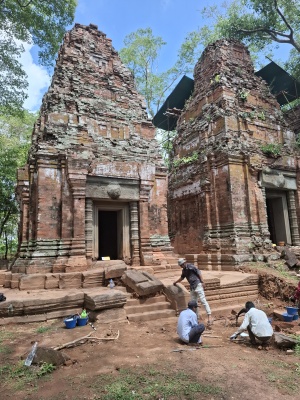c After days of marveling at the grandeur of Angkor Wat, we craved something quieter, wilder—less touched by tourist footprints. That’s how we ended up on a day trip to Koh Ker, a forgotten ancient capital tucked deep in the Cambodian jungle, about 2.5 hours from Siem Reap. And what a day it was!
The drive itself felt like peeling back the layers of time. As we left behind the tuk-tuks and cafes of Siem Reap, rice paddies stretched wide under the morning sun, and water buffalo lazed in the fields. Villages appeared like mirages—wooden stilt houses, children waving, roadside stalls with coconuts, sticky rice and gasoline in glass bottles.
Then the trees thickened. The road narrowed. And suddenly, Koh Ker appeared like a secret—its stone towers poking through the canopy, weathered and silent.
The centerpiece, Prasat Thom, is a seven-tiered pyramid rising from the earth like Cambodia’s own step pyramid. Climbing to the top (a recent wooden staircase makes it easy) rewarded us with sweeping jungle views that felt utterly untouched. Unlike Angkor’s crowds, here we were often alone—just us, two other couples, the wind, and ancient stones.
What struck us most was how raw and powerful the place felt. Many temples are partially reclaimed by nature, with strangler figs twisting through walls and lichen painting the carvings. Each ruin seemed to whisper its own story:
Prasat Pram, with trees growing through its brick towers, felt like something from a dream. It is a captivating 10th-century temple ensemble renowned for its unique architecture and natural integration. The name "Pram," meaning "five" in Khmer, reflects its composition of five towers—three aligned brick towers on a shared platform facing east, and two additional towers in front, one constructed of brick and the other of laterite. Notably, some of these structures are dramatically entwined with the roots of fig trees, creating a striking visual reminiscent of nature reclaiming ancient architecture. Originally, these towers housed sacred lingas, and remnants of white stucco can still be observed on their surfaces. Artifacts from Prasat Pram, including a damaged lion statue and fragments of a four-armed Vishnu, are preserved in the National Museum in Phnom Penh.
Prasat Balang cheung, also known as Linga Temple, is a significant 10th-century Hindu temple dedicated to Shiva and exemplifies the Koh Ker architectural style. The water poured over the linga would become sanctified and collected by the believers.
Prasat Neang Khmao – Black Lady Temple, is a 10th-century sanctuary located within the Koh Ker complex in northern Cambodia. Constructed primarily of laterite atop a sandstone base, the temple features a square design with tiered levels and decorative corner elements. Its darkened exterior, possibly due to fire damage, lends the temple its name. Dedicated to the Hindu deity Shiva, Prasat Neang Khmao stands as one of the best-preserved structures in the area, offering visitors a glimpse into the architectural and spiritual heritage of the Khmer Empire.
By late afternoon, with our shoes dusty and our phones full of memorable pictures, we realized Koh Ker wasn’t just a detour—it was a revelation. If Angkor is Cambodia’s polished crown jewel, Koh Ker is its wild heart.
We returned to Siem Reap tired but glowing, grateful for the stillness, the mystery—and the reminder that wonder often lies just off the main road.






